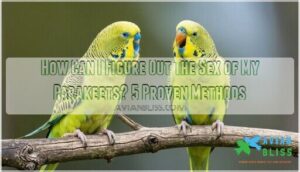This site is supported by our readers. We may earn a commission, at no cost to you, if you purchase through links.
 You can figure out the sex of your parakeets by examining the cere (the fleshy area above their beak) – males typically show bright blue or purple coloration while females display white, tan, or brown hues.
You can figure out the sex of your parakeets by examining the cere (the fleshy area above their beak) – males typically show bright blue or purple coloration while females display white, tan, or brown hues.
Behavioral differences also help: males are chattier mimics who love showing off with head bobs and fancy footwork, while females tend to be more territorial and spend time rearranging their living space.
Keep in mind that young birds under six months are tricky to sex since their ceres remain pale and pinkish regardless of gender.
The good news? Once your feathered friends hit that six-month milestone, these identification methods become surprisingly reliable – though there are a few additional tricks that can boost your accuracy even further.
Table Of Contents
- Key Takeaways
- How Can I Figure Out The Sex of My Parakeets?
- Cere Color as a Gender Indicator
- Behavioral Cues for Gender Determination
- Other Gender Identification Methods
- Frequently Asked Questions (FAQs)
- Can I determine the gender of my parakeet by its color?
- Are there any behavioral differences between male and female parakeets?
- My parakeet’s cere color seems to change. What does this mean?
- How do you know if a parakeet is male or female?
- What is the sex of a parakeet?
- Are male parakeets louder than females?
- How do you know if a budgie parakeet is male or female?
- What age can a parakeet be sexed?
- What is a female parakeet called?
- How do you find out your bird’s gender?
- Conclusion
Key Takeaways
- You’ll get the most reliable results by examining your parakeet’s cere coloring – males show bright blue or purple coloring while females display white, tan, or brown hues after 6 months of age
- You can spot behavioral differences where males are chattier mimics who perform head-bobbing displays, while females tend to be more territorial and spend time rearranging their space
- You shouldn’t rely on sexing methods for birds under 6 months old since young parakeets have pale, pinkish ceres that don’t indicate gender accurately
- You can use DNA testing as a backup method when visual cues fail, especially with color mutations that make cere identification unreliable
How Can I Figure Out The Sex of My Parakeets?
Figuring out your parakeet’s sex isn’t always as straightforward as you’d think. Unlike many animals where gender differences are obvious, parakeet sexing requires a keen eye and patience.
These colorful companions don’t make it easy – especially when they’re young or have unique color mutations that throw traditional gender signs out the window. The good news? You’ve got several reliable methods at your disposal.
From examining physical characteristics to observing bird behavior patterns, determining parakeet gender becomes much simpler once you know what to look for. Whether you’re planning for breeding tips or simply curious about your feathered friend, understanding budgie sex determination helps you provide better pet care.
Understanding their social behavior traits is essential for creating a harmonious environment. Some methods work better than others, and timing matters.
Young birds under a year old can be particularly tricky to sex accurately, making patience your best friend in this process.
Cere Color as a Gender Indicator
The cere color method is your best starting point for parakeet sex determination. This fleshy patch above your bird’s beak tells quite a story about gender.
Your parakeet’s cere holds the secret to determining gender—it’s nature’s built-in identification card
That tiny patch above your parakeet’s beak holds the key to solving the gender mystery.
Here’s what you’ll typically see:
- Adult males display bright royal blue or purple ceres, especially during breeding season
- Adult females show white, tan, or brown ceres that become crusty when fertile
- Young birds under 12 months have pale, pinkish ceres that aren’t reliable gender signs
- Color mutations like albino or lutino can produce lavender ceres in both sexes
Don’t expect instant answers though. Cere color changes happen gradually as your parakeet cere develops adult coloration. Budgie cere identification works best after six months of age when hormones kick in.
Keep in mind that beak changes aren’t always black and white. Some females maintain lighter ceres, while stressed males might show brownish tones. Sexing methods using cere color achieve about 90% accuracy in standard varieties, making it a solid first step in parakeet sex determination. Understanding hormone effects is essential for accurate parakeet sexing.
Behavioral Cues for Gender Determination
Watching your parakeet’s personality unfold reveals telling clues about their gender. Vocal Patterns stand out as the most reliable behavioral indicator—males typically chatter away with complex songs and melodies, while females stick to shorter, harsher calls. Research shows males mimic sounds 2.5 times more often than their female counterparts.
Your parakeet’s chatter reveals their gender secrets—males are nature’s vocal performers while females keep conversations brief
Social Interactions also differ between the sexes. Males bounce between groups like social butterflies, while females prefer smaller, stable circles. You’ll notice Territorial Traits emerge more strongly in females, who guard their favorite perches and food bowls with surprising determination.
Here are three key behavioral cues to watch for:
- Courtship Behaviors: Males perform elaborate mating behaviors including head bobbing and dancing routines
- Aggression levels: Females display 38% more competitive pecking and territorial disputes
- Nesting activities: Females spend substantially more time shredding materials and rearranging cage bedding
Understanding bird sex differences is vital for identifying parakeet behavior. Remember, individual personalities vary widely. Some males act reserved while certain females become chatterboxes. Observe your bird’s consistent patterns over several weeks for the most accurate gender identification through parakeet behavior.
Other Gender Identification Methods
When visual cues fall short, you’ve got backup methods that’ll crack the gender code. DNA testing offers 99.9% accuracy through simple feather or blood samples—it’s the gold standard for parakeet gender identification when cere color misleads you.
Molecular sexing uses PCR technology to detect sex-specific markers, delivering results in 3-7 days. Surgical sexing through endoscopy lets vets visually inspect internal organs, though it’s riskier and pricier than DNA options.
Egg laying provides definitive female confirmation, but absence doesn’t guarantee male status since some hens never lay. Professional parakeet sexing combines these scientific methods with behavioral cues for thorough identification.
While DNA testing costs more upfront, it eliminates guesswork entirely—especially valuable for breeding programs or when mutations cloud visual assessment. Understanding cardinal sex differences can also inform broader approaches to bird gender identification.
Frequently Asked Questions (FAQs)
Can I determine the gender of my parakeet by its color?
Color alone won’t crack the code.
While body feather colors aren’t reliable gender markers, the cere (waxy patch above the beak) tells the real story.
Males sport blue or purple ceres, while females display white, tan, or brown ones.
Are there any behavioral differences between male and female parakeets?
Male parakeets tend to be more vocal singers and chattier, while females make aggressive squawks.
Males perform head-bobbing courtship dances, but females become territorial and bossy, especially when broody or nesting.
My parakeet’s cere color seems to change. What does this mean?
Approximately 90% of parakeet owners struggle with changing cere colors during their bird’s first year.
Your parakeet’s shifting cere color likely indicates it’s still maturing sexually.
Young birds under 12 months show inconsistent colors before developing stable adult hues.
How do you know if a parakeet is male or female?
Check your parakeet’s cere – that fleshy patch above the beak. Males typically have bright blue or purple ceres, while females show white, tan, or brown ones.
What is the sex of a parakeet?
Like reading a bird’s ID badge, you’ll determine your parakeet’s sex by examining the cere—that fleshy patch above their beak.
Males sport blue or purple ceres, while females display white, tan, or brown ones.
Are male parakeets louder than females?
Actually, it’s the opposite – females tend to be louder than males.
You’ll notice your female parakeets making more aggressive squawks and flock calls, while males typically sing melodious songs to attract mates.
How do you know if a budgie parakeet is male or female?
Adult male budgies sport bright blue ceres while females display white, tan, or brown ones.
You’ll also notice males sing more melodiously and bob their heads, while females tend to be bossier and less musical.
What age can a parakeet be sexed?
You can reliably sex parakeets around 3-4 months old when their cere colors develop. Males show blue or purple ceres, while females display white, tan, or brown ones.
What is a female parakeet called?
Picture a tiny queen ruling her perch—a female parakeet is simply called a hen.
Don’t expect royal fanfare; she’s just your girl bird, likely bossy and clever, full of personality and nesting ambitions!
How do you find out your bird’s gender?
You can determine your bird’s gender by examining the cere (fleshy area above the beak). Males typically have blue or purple ceres, while females show white, tan, or brown coloring.
Conclusion
Congratulations, you’ve officially joined the ranks of amateur bird detectives!
Now that you know how to figure out the sex of your parakeets through cere examination, behavioral observation, and additional identification methods, you’re equipped with reliable tools for gender determination.
Remember, patience is key since birds under six months won’t show clear indicators.
These proven techniques work best when combined rather than used individually.
With practice, you’ll become surprisingly accurate at identifying whether your feathered companions are boys or girls.






